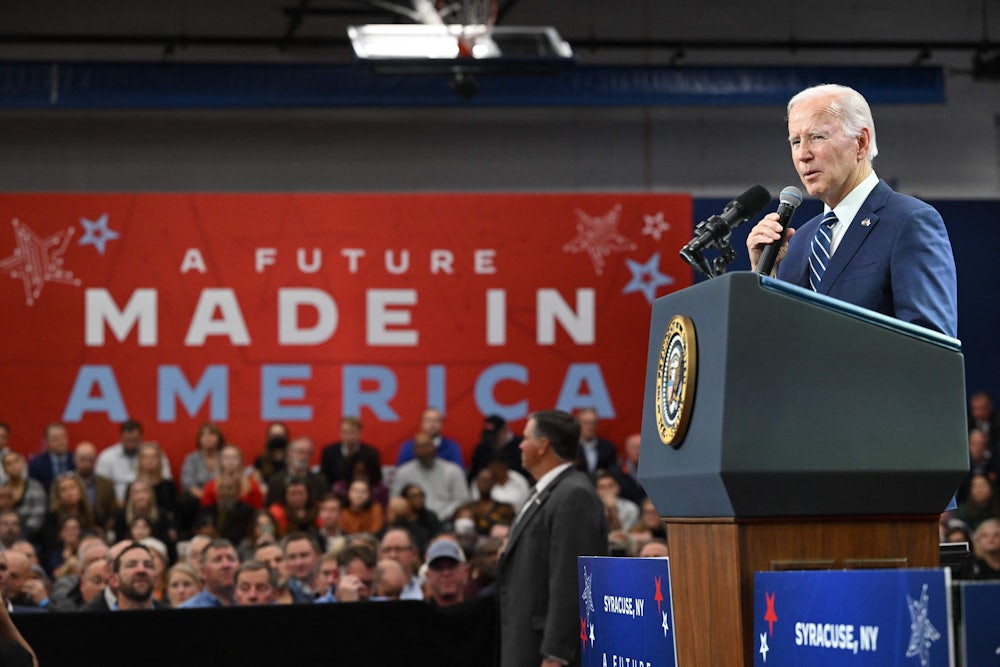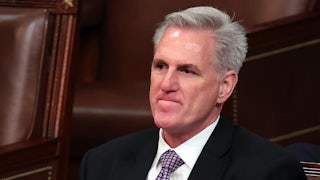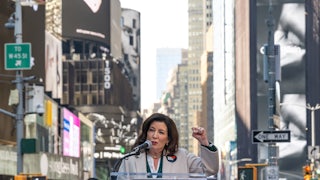Let’s start by clearing up a media oversimplification: It isn’t true that Democratic campaigns “ignored” the economy until last week. Sure, they emphasized abortion rights. But this Washington Post summary of ad campaign spending that ran on October 25 shows a more complex picture. Up to that point, according to the Post, Democrats had spent $103 million on abortion-related ads but also $20 million on ads related to jobs (more than the Republicans), $28 million on ads related to health care, and $53 million on ads related to Social Security and Medicare. I count those last three as “economic” in nature because they all come down to dollars and cents in people’s daily lives. The bottom line: Democrats haven’t ignored the economy.
Still, let’s face it, it’s generally true that with inflation at 8 percent, there’s only so much Democrats can say, and they just aren’t going to win many economic arguments. There are signs that inflation is easing and that a recession isn’t in the offing. But the narrative is already set, inaugurated by the right-wing media and picked up by the mainstream press. Low-information swing voters don’t know or care that inflation is higher in Europe. Voting has started in most states, and Election Day is only eight days away. It’s probably too late to change the narrative for this election.
But here’s the longer-term job the Democrats need to do on the economy, and they might as well start now. It comes in three parts.
First, they have to persuade voters that they are better stewards of the economy. As I show below, they have been, and by a light-year.
Second, they need to tell a sharper economic story that identifies enemies of working people’s economic interests by name.
And third, they need to start telling voters that their economic ideas, in addition to putting more money in working- and middle-class people’s pockets, as well as getting them more health care and childcare and the like, will strengthen democracy and expand personal freedom.
On the first point: Every poll I’ve ever seen that asks “which party is better for the economy” shows that American voters favor Republicans. They’re the party of business, after all. It’s about that simple. In addition, the presumptions voters have been brainwashed into believing over these last four decades—private spending good, public spending bad—makes it easy for Republicans to argue that Joe Biden and the socialistic Democrats caused inflation with all that irresponsible big spending. With the existing presumptions in place, it makes an intuitive sense that all that public-sector spending has grim consequences for the private-sector economy.
It’s all lies. In the last 30 years, Republican presidents have wrecked the economy, and Democratic presidents have revived it. But it’s the Democrats’ fault that this reality isn’t more widely understood among the public.
Think about it: Since 1989, we’ve had three Republican presidents and three Democratic ones. Have you ever heard a single Democratic politician point out that each of those three Republican presidents left an economic mess—each one more severe than the last—that his Democratic successor had to clean up? I sure haven’t.
But it’s true. George H.W. Bush presided over a double-dip recession. George W. Bush over the near-meltdown of the global economy. Donald Trump over a massive pandemic-driven economic free fall (the pandemic wasn’t his fault, but his denialism and slow response surely were).
Enter the Democrats. Bill Clinton passed a 1993 budget bill—without a single GOP vote—that increased investments and raised a tax (it’s the last time the federal gas tax was increased) and helped lay the groundwork for the late-’90s boom. Barack Obama passed a large (though not large enough) stimulus that staunched the bleeding and eventually helped lead to many consecutive months of job growth. And Joe Biden has passed the big bills we know about—the American Rescue Plan, the hard infrastructure bill, the CHIPS and Science act, and the Inflation Reduction Act—while presiding over impressive job and wage growth.
Some numbers tell the story more dramatically. In the 32 years from 1988 to 2020, this country had 16 years of Republican presidencies and 16 years of Democratic ones. That’s a good basis on which to compare five categories that most people would agree can fairly be added up to represent economic performance. According to work done by Simon Rosenberg of the liberal think tank NDN and a little numbers-crunching I’ve done on my own, here’s how it looks.
Jobs created: under Democrats, 33.8 million; under Republicans, 1.9 million.
Gross domestic product growth: Democrats, 3.1 percent; Republicans, 1.62 percent.
Median household income increase: Democrats, 9.5 percent; Republicans, 0.6 percent. Yes, that’s zero-point-six, not six.
Dow Jones average increase: Democrats, 185.5 percent; Republicans, 26 percent.
Deficit reduction/increase: Democrats reduced red ink by $400 billion; Republicans increased it by—ready?—$3.5 trillion.
These are not typos. Most of the gaudy Democratic numbers are due to Clinton, under whom 22 million jobs were created, the stock market boomed, and a $290 billion deficit became a $236 billion surplus. But more than 11 million jobs were created under Obama. And on the topic of job creation, we can now add the 10.5 million jobs created during Biden’s tenure, so the numbers there are now 44.3 million to 1.9 million. (All this, by the way, is spelled out at greater length in my new book, The Middle Out.)
A conservative will object to the above numbers on various grounds. First, they are arrived at by simply adding the jobs numbers for the months that a president held office. That’s admittedly imprecise. But there’s no precise way to measure when a president’s economic policies kick in. It’s also why I write above that 22 million jobs were created under Clinton, and not that Clinton created 22 million jobs. Phrased that way, it’s a fair measure to use. And besides, let’s put it this way: If the numbers were reversed, who thinks Republicans would be shy about touting them?
Conservatives will also note that these numbers conveniently omit Ronald Reagan. Adding him changes things a bit, but not that dramatically. Reagan had impressive jobs numbers, for example, second only to Clinton’s in recent history. But he roughly doubled Jimmy Carter’s deficit. And the stock market did less well under Reagan than under both Clinton and Obama. Besides, how many decades are Republicans allowed to dine out on Ronald Reagan? His presidency was an entirely different era; if Reagan were in his political prime today, neither he nor his economic ideas (he agreed to compromise tax increases several times) would be welcome in today’s GOP.
Finally, those on the right will point out that Trump’s numbers were solid before the pandemic. They were: About seven million jobs were created under Trump pre-pandemic. But that’s still about 1.3 million fewer than during the equivalent period of Obama’s second term.
So that’s job one. Why don’t Democratic House and Senate candidates tout these numbers? It’s my guess that most of them don’t even know them. The only time I’ve ever heard a high-profile Democrat talk along these lines was Bill Clinton at the 2012 convention. But even that was only five sentences. If they were a little more on the ball at the DNC, they’d make every Democratic candidate for federal office in the country memorize the above numbers.
Now to the second task. The group Unrig Our Economy did some interesting polling earlier this year. Its survey tested 11 different liberal economic messages and found that the two that were most effective, particularly when paired, were (1) the economy does best when the middle class does better (the basic idea of “middle-out” economics), and (2) the system is rigged for corporations and the wealthy.
Democrats need to build their economic case around the middle class. That, also, is the point of my book, as it is the point of a decade’s worth of impressive intellectual spade work in liberal circles, which is the story I tell in the book. This may seem obvious, but Democrats actually have a lot of ground to make up here. As Unrig’s Sarah Baron told me recently, nearly as many respondents associated helping the middle class with Republicans as with Democrats, so “Democrats weren’t going to get credit for ‘middle-out.’”
As for the second part: This isn’t brain surgery. Getting people to listen to you and hear what you’re saying isn’t about just citing statistics. Even as striking as the above statistics are, people will forget them if they’re not surrounded by a narrative. That means telling stories. Democrats are lousy at telling stories. Why? One simple reason: They’re hesitant to name villains.
Stories need villains. Name me a Disney movie that doesn’t have a villain. You can’t. Republicans get the importance of this. They name villains all the time. It’s just about all they do: Nancy Pelosi (which helped lead to what happened last Friday), George Soros, transgender children, immigrants, you name it.
The Democrats’ villains ought to be clear enough. Corporations and the wealthy, sure, but … specific corporations and specific rich people. Naming real names packs a far stronger emotional punch. But most Democrats seem afraid to single out Novo Nordisk (the main maker of insulin) or Meta (Facebook) or Cargill (meat) or Jeff Zuckerberg or Peter Thiel or Elon Musk (maybe they’ll finally do that last one now that he’s openly embraced neofascism and irresponsibly speculative conspiracy theories about Paul Pelosi). I imagine it has a lot to do with campaign contributions, especially in the tech sector. This has to stop. It shouldn’t be hard for most politicians to go online and tell people Hey, I’ve quit taking tech money, can you please send me $10? I’m willing to bet they’ll raise more money as they unmuddy the waters about who they’re truly working for. They can’t be on the side of working people if they’re watching their words because of campaign contributions.
Third: Economics and democracy and freedom are all interrelated. This too is the topic of my book, and I’ve been gratified in these recent weeks to see more and more people (on MSNBC, say) talk about how the Democrats ought to be arguing that their economic ideas will strengthen democracy.
But they also have to emphasize freedom—and redefine it. The right’s definition of freedom is the unfettered free market, which has in fact devastated many erstwhile manufacturing towns in America, and the freedom to go shoot up a bunch of schoolchildren. The liberal definition of freedom needs to include women’s freedom over their bodily autonomy and the freedom of schoolchildren not to have to worry that they’ll be massacred in the classroom. But it has to be chiefly economic: Freedom means the freedom of people to reach their fullest human potential, pursue happiness, and lead lives of dignity and stability. That means giving them the tools to do so: free (or very affordable) community college, a safe place to put their kids while they take those night classes, a child tax credit, and so on.
So this is the plan: prove the case that they’ve been far better economic managers; tell a story with good guys and bad guys; tie their economic ideas to larger ideals Americans are taught to cherish from childhood. And Democrats should commit themselves to this task and look for opportunities to make their argument every day. No, there isn’t time to change the game by next Tuesday. But give it eight days and two years.










